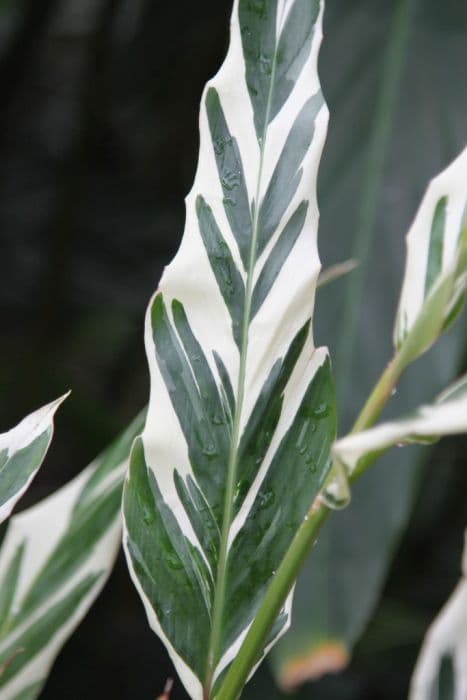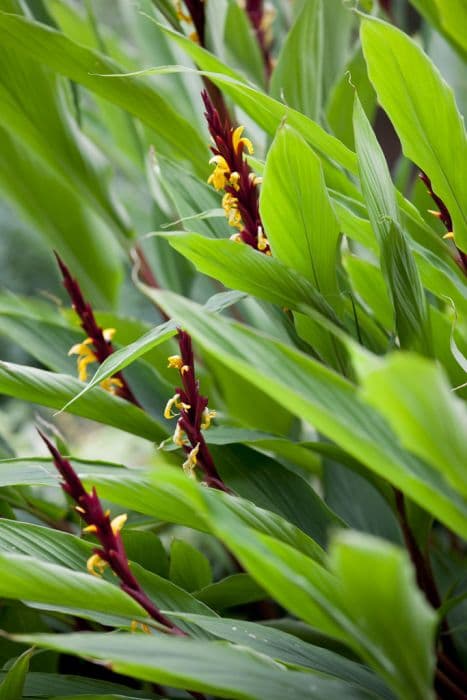Roscoea Roscoea 'McBeath's Pink'

ABOUT
Roscoea 'McBeath's Pink' is a perennial plant that features distinctive foliage and lovely flowers. It has narrow, lance-shaped leaves that create an attractive, clump-forming base. The foliage can range from a lush green to slightly bluish-green color, providing a beautiful backdrop for the blooms. The real highlight of this plant is its stunning flowers. The blooms have a prominent, tubular shape and are typically a soft, pastel pink color—hence the name 'McBeath's Pink'. Each flower is delicate and orchid-like, with petals that sometimes display a paler edge, giving a gentle contrast to the overall flower color. The blooms are arranged atop slender, upright stems that rise gracefully from the foliage below. The flowers themselves can be quite showy, with the attractive color luring in pollinators such as bees and butterflies. Blooming typically occurs in the summer and can last for several weeks, providing a sustained display of color in the garden. Overall, Roscoea 'McBeath's Pink' is a charming and elegant addition to any garden with its striking pink flowers and graceful green foliage.
About this plant
 Names
NamesSynonyms
McBeath's Pink Roscoea, Pink Dragon Ginger
Common names
Roscoea 'McBeath's Pink'
 Toxicity
ToxicityTo humans
The Roscoea, commonly known as the Ginger family, to which 'McBeath's Pink' belongs, is not known to be toxic to humans. Therefore, ingesting parts of the plant is unlikely to cause poisoning or adverse health effects.
To pets
Similar to humans, the Roscoea species, including 'McBeath's Pink', which is a part of the Ginger family, is not known for being toxic to pets. Consequently, ingestion is unlikely to result in poisoning or serious health issues in animals. However, it's always prudent to prevent pets from eating plants as individual animals might have different sensitivities or allergic reactions.
 Characteristics
CharacteristicsLife cycle
Perennials
Foliage type
Deciduous
Color of leaves
Green
Flower color
Pink
Height
1-2 feet (30-60 cm)
Spread
1 foot (30 cm)
Plant type
Herb
Hardiness zones
6
Native area
Asia
Benefits
 General Benefits
General Benefits- Aesthetic Appeal: Roscoea 'McBeath's Pink' offers beautiful soft pink flowers that can add a delicate and striking visual interest to gardens and landscapes.
- Low Maintenance: This plant is relatively easy to care for, requiring minimal maintenance once established, suitable for gardeners of all skill levels.
- Drought Resistance: Once established, it is fairly drought-tolerant, making it a good choice for regions with less frequent rainfall or for water-wise gardening.
- Attracts Pollinators: The vibrant flowers attract bees and other pollinators, which are beneficial for the health of the garden and the environment.
- Compact Growth Habit: Its moderate size makes it suitable for smaller gardens, containers, or borders without overpowering other plants.
- Cold Hardiness: Roscoea 'McBeath's Pink' is cold hardy in certain climates, allowing it to survive and thrive in cooler temperatures.
 Medical Properties
Medical PropertiesThis plant is not used for medical purposes.
 Air-purifying Qualities
Air-purifying QualitiesThis plant is not specifically known for air purifying qualities.
 Other Uses
Other Uses- Roscoea 'McBeath's Pink', commonly known as ginger lily, can be used in floral arrangements for its striking flower color, adding an exotic touch to bouquets and centerpieces.
- The tuber of the ginger lily is sometimes used as a natural source of purple or pink dye for fabrics, taking advantage of its pigmented roots.
- Throughout its growing season, the ginger lily can serve as a natural indicator of soil pH depending on the color intensity of its flowers, which may vary with soil conditions.
- The ginger lily's robust foliage can provide shelter and micro-habitats for beneficial insects and small garden fauna, promoting biodiversity.
- When ginger lily is planted in groups, it can act as an erosion control plant due to its clumping nature and root system, helping to stabilize soil in sloped gardens.
- This plant can be used in sensory gardens, as its flowers have a subtle fragrance that can add an aromatic dimension to the garden experience.
- Ginger lily can be incorporated into educational gardens where students can learn about plant genus Roscoea and its characteristics through direct observation.
- In frost-free areas, the ginger lily can be grown in containers and brought indoors during colder months, serving as a decorative indoor plant with its attractive flowers.
- The tubers of the ginger lily can be used in compost or worm farms as organic matter, contributing to the nutrient cycle when they are no longer viable for propagation.
- For nature photography enthusiasts, the vibrant pink flowers of the ginger lily provide an excellent subject for practicing macro and plant photography skills.
Interesting Facts
 Feng Shui
Feng ShuiThe plant Roscoea is not used in Feng Shui practice.
 Zodiac Sign Compitability
Zodiac Sign CompitabilityThe plant Roscoea is not used in astrology practice.
 Plant Symbolism
Plant Symbolism- Resilience: Roscoea species, including 'McBeath's Pink', often emerge from tough mountainous habitats, symbolizing the ability to thrive amidst challenging conditions.
- Rarity: As a less common ornamental plant, 'McBeath's Pink' may represent uniqueness or the precious nature of something uncommon or sought-after.
- Charm: The delicate and attractive pink flowers of 'McBeath's Pink' can symbolize charm and gentle beauty.
- Adaptation: This plant's adaptability to various growing conditions can symbolize versatility and the ability to adjust to different situations in life.
 Water
WaterGinger family plant Roscoea 'McBeath's Pink' requires consistent moisture during the growing season, so water when the top inch of soil feels dry. It's best to water this plant once or twice a week, depending on the weather conditions, with about 16-32 ounces of water each time. During hot summers, the watering frequency should be increased to maintain adequate soil moisture. However, reduce watering during the dormant winter period to prevent root rot. Always use tepid water and avoid letting the plant sit in standing water.
 Light
LightRoscoea 'McBeath's Pink', a member of the ginger family, thrives best in partial shade where it receives a few hours of morning sunlight but is protected from the harsh afternoon sun. A spot that offers dappled sunlight throughout the day is ideal for this plant, as it mimics its natural woodland habitat.
 Temperature
TemperatureThe ginger family plant Roscoea 'McBeath's Pink' prefers a temperate climate and grows best in temperatures ranging from 50 to 75 degrees Fahrenheit. It can withstand minimum temperatures down to about 32 degrees Fahrenheit, but should be protected from freezing conditions. The plant’s ideal growing temperature is between 60 and 70 degrees Fahrenheit.
 Pruning
PruningPruning of the ginger family plant Roscoea 'McBeath's Pink' isn’t regularly required, but deadheading spent flowers can encourage further blooming. In late fall, after the foliage has died back, cut the plant down to ground level. This should be done annually to keep the plant healthy and to remove any dead or diseased tissue.
 Cleaning
CleaningAs needed
 Soil
SoilFor the hardy ginger (Roscoea 'McBeath's Pink'), the best soil mix is a well-draining, humus-rich medium with perlite or sand for improved drainage. The soil pH should be slightly acidic to neutral, ideally between 6.0 and 7.0.
 Repotting
RepottingThe hardy ginger typically requires repotting every two to three years or when it outgrows its current container. It is best done in the spring as the plant comes out of dormancy.
 Humidity & Misting
Humidity & MistingThe hardy ginger thrives best in moderate to high humidity levels, ideally between 50% and 70%, mimicking its native Himalayan environment.
 Suitable locations
Suitable locationsIndoor
Place hardy ginger in bright, indirect light with moist soil.
Outdoor
Plant hardy ginger in partial shade with shelter from strong winds.
Hardiness zone
6-9 USDA
 Life cycle
Life cycleThe life cycle of Roscoea 'McBeath's Pink', also known as McBeath's Pink Ginger, begins when rhizomes or seeds are planted in early spring. The plant then germinates, developing shoots that emerge from the soil once temperatures become sufficiently warm. Through the growing season, leaves unfold and stems elongate, eventually producing distinctive orchid-like pink flowers during the late spring to summer months. After pollination, which is typically by insects, the flowers develop into seed capsules if conditions allow. As the season progresses into late summer and fall, the aerial parts of the plant die back, leaving the rhizome dormant through the winter. In subsequent years, the rhizome will continue to produce new growth, repeating the cycle and slowly expanding the plant's footprint in the garden.
 Propogation
PropogationPropogation time
Late Summer
For Roscoea 'McBeath's Pink', also commonly known as Roscoea, division is the most popular method of propagation. The best time to propagate Roscoea by division is in the spring, just before the new growth begins. Carefully lift the clump of the plant from the ground and gently separate the rhizomes, ensuring that each section has at least one growth bud. These sections can then be replanted in well-draining soil at a depth of about 2 to 4 inches (roughly 5 to 10 centimeters), spacing them about 8 to 12 inches (approximately 20 to 30 centimeters) apart to allow for growth. Water the new divisions well to help establish them. This method allows the gardener to create new plants that are genetically identical to the parent, maintaining the unique characteristics of 'McBeath's Pink'.









